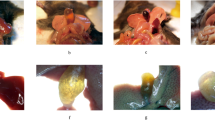Abstract
Aim
Because dyslipidemia, such as hypercholesterolemia, is a characteristic of primary biliary cirrhosis (PBC), hepatic lipid metabolism may be disturbed in PBC patients. We examined the expression of lipid metabolism-associated genes in PBC liver.
Methods
All of the patients examined were in stage I or II PBC and without medication. RNA was isolated from liver specimens by needle biopsies of PBC patients and controls. The expression levels of various genes were measured by real-time RT-PCR. Multidrug resistance 3 (MDR3) expression was examined immunohistochemically. Statistical correlations between the gene expression levels and indices of blood testing were calculated.
Results
The expression levels of sterol regulatory element-binding protein (SREBP) 2 and LDL receptor were significantly lower, and those of apolipoprotein B, microsomal triglyceride transfer protein, ATP-binding cassette G5, and liver X receptor α (LXRα) were significantly higher in the PBC liver than in the normal control liver. The expression levels of bile acid synthesis- and excretion-associated genes did not change, and those of farnesoid X receptor, peroxisome proliferator-activated receptor α, and SREBP-1c were similar between the PBC and normal liver. MDR3 gene expression levels in the PBC liver were more than 4-fold higher than those in the control liver. Immunohistochemically, strong canalicular staining for MDR3 was observed in the PBC liver. LXRα expression was positively correlated with MDR3 levels. Serum levels of γ-glutamyl transpeptidase (GGT) and IgM were negatively correlated with MDR3 levels.
Conclusions
Hepatocellular cholesterol metabolism was at least partially disturbed, even in the early stage of PBC. The most characteristic finding was a distinct elevation of MDR3 expression, and the MDR3 levels were negatively correlated with GGT and IgM levels.






Similar content being viewed by others
References
Goldstein JL, Debose-Boyd RA, Brown MS. Protein sensors for membrane sterols. Cell 2006;124:35–46
Wójcicka G, Jamroz-Wiśniewska A, Horoszewicz K, Bełtowski J. Liver X receptors (LXRs); part I: structure, function, regulation of activity, and role in lipid metabolism. Postepy Hig Med Dosw 2007;61:736–759
Kidambi S, Patel SB. Cholesterol and non-cholesterol sterol transporters: ABCG5, ABCG8 and NPC1L1: a review. Xenobiotica 2008;38:1119–1139
Kato M, Higuchi N, Enjoji M. Reduced expression of ATGL and CGI-58 in the liver may attribute to develop NAFLD in patients with insulin resistant background. Scand J Gastroenterol 2008;43:1018–1019
Van Erpecum KJ. Biliary lipids, water and cholesterol gallstones. Biol Cell 2005;97:815–822
Jansen PLM, Sturm E. Genetic cholestasis, causes and consequences for hepatobiliary transport. Liver Int 2003;23:315–322
Oude Elfrrink RPJ, Paulusma CC. Function and pathophysiological importance of ABCB4 (MDR3 P-glycoprotein). Eur J Physiol 2007;453:601–610
Matsumoto T, Miyazaki H, Nakahashi Y, Hirohara J, Seli T, Inoue K, et al. Multidrug resistance3 is in situ detected in the liver of patients with primary biliary cirrhosis, and induced in human hepatoma cells by bezafibrate. Hepatol Res 2004;30:125–136
Zollner G, Fickert P, Zenz R, Fuchsbichler A, Stumptner C, Kenner L, et al. Hepatobiliary transporter expression in percutaneous liver biopsies of patients with cholestatic liver diseases. Hepatology 2001;33:633–646
Zollner G, Fickert P, Silbert D, Fuchsbichler A, Marschall HU, Zatloukal K, et al. Adaptive changes in hepatobiliary transporter expression in primary biliary cirrhosis. J Hepatol 2003;38:717–727
Ros JE, Libbrecht L, Geuken M, Jansen PLM, Roskams TAD. High expression of MDR1, MRP1, and MRP3 in the hepatic progenitor cell compartment and hepatocytes in severe human liver disease. J Pathol 2003;200:553–560
Borst P, Evers R, Kool M, Wijnholds J. The multidrug resistance protein family. Biochim Biophys Acta 1999;1461:347–357
Kanda T, Yokosuka O, Imazeki F, Saisho H. Bezafibrate treatment: a new medical approach for PBC patients? J Gastroenterol 2003;38:573–578
Dohmen K, Mizuta T, Nakamuta M, Shimohashi N, Ishibashi H, Yamamoto K. Fenofibrate for patients with asymptomatic primary biliary cirrhosis. World J Gastroenterol 2004;10:894–898
Kita R, Takamatsu S, Kimura T, Kokuryu H, Osaki Y, Tomono N. Bezafibrate may attenuate biliary damage associated with chronic liver diseases accompanied by high serum biliary enzyme levels. J Gastroenterol 2006;41:686–692
Chinale J, Vollrath V, Wielandt AM, Amigo L, Rigotti A, Nervi F, et al. Fibrate induce mdr2 gene expression and biliary phospholipids secretion in the mouse. Biochem J 1996;314:781–786
Shoda J, Inada Y, Tsuji A, Kusama H, Ueda T, Ikegami T, et al. Bezafibrate stimulates canalicular localization of NBD-labeled PC in HepG2 cells by PPARα-mediated redistribution of ABCB4. J Lipid Res 2004;45:1813–1825
Shoda J, Okada K, Inada Y, Kusama H, Utsunomiya H, Oda K, et al. Bezafibrate induces multidrug-resistance P-glycoprotein 3 expression in cultured human hepatocytes and humanized livers of chimeric mice. Hepatol Res 2007;37:548–556
Iwasaki S, Tsuda K, Ueta H, Aono R, Ono M, Saibara T, et al. Bezafibrate may have a beneficial effect in pre-cirrhotic primary biliary cirrhosis. Hepatol Res 1999;16:12–18
Kuntz E, Kuntz HD. Hepatology: Principles and Practice. Berlin: Springer, 2001; 580–590
Pauli-Magnus C, Kerb R, Fattinger K, Lang T, Anwald B, Kullak-Ublick GA, et al. BSEP and MDR3 haplotype structure in healthy Caucasians, primary biliary cirrhosis and primary sclerosing cholangitis. Hepatology 2004;39:779–791
Ohishi Y, Nakamura M, Iio N, Higa S, Inayoshi M, Aiba Y, et al. Single-nucleotide polymorphism analysis of the multidrug resistance protein 3 gene for the detection of clinical progression in Japanese patients with primary biliary cirrhosis. Hepatology 2008;48:853–862
Author information
Authors and Affiliations
Corresponding author
Rights and permissions
About this article
Cite this article
Enjoji, M., Yada, R., Fujino, T. et al. The state of cholesterol metabolism in the liver of patients with primary biliary cirrhosis: the role of MDR3 expression. Hepatol Int 3, 490–496 (2009). https://doi.org/10.1007/s12072-009-9137-y
Received:
Accepted:
Published:
Issue Date:
DOI: https://doi.org/10.1007/s12072-009-9137-y




